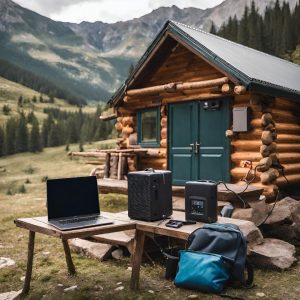Running HVAC and Major Appliances Off Grid with Jackery Stations: A Comprehensive Guide

If you're someone who's interested in off-grid living, you may be wondering how you can power your HVAC system and major appliances without being connected to the grid. Luckily, there are portable power stations like Jackery that can provide a solution. With the right Jackery station, you can keep your home cool in the summer and warm in the winter, while still being able to power essential appliances like refrigerators and stoves. Follow along below as we discuss running HVAC and major appliances off grid with Jackery stations.
Understanding Off-Grid Power Basics is the first step to figuring out how to run your HVAC and major appliances off-grid. Off-grid power systems are typically made up of solar panels, batteries, and an inverter. Solar panels collect energy from the sun, which is then stored in batteries. The inverter converts the stored energy from DC to AC, which can be used to power your home. With a portable power station like Jackery, you can skip the solar panel and battery setup and have a complete off-grid power solution in one device.
Selecting the Right Jackery Station for Your Needs is crucial for running your HVAC and major appliances off-grid. Jackery offers a range of portable power stations with different capacities and features. The higher the capacity, the more appliances you can power and the longer the station will last. It's also important to consider the type of appliances you want to power, as some may require more wattage than others. With the right Jackery station, you can have a reliable and efficient off-grid power source for your home.
Key Takeaways
- Off-grid power systems are made up of solar panels, batteries, and an inverter.
- Jackery offers a range of portable power stations with different capacities and features.
- With the right Jackery station, you can have a reliable and efficient off-grid power source for your home.
Understanding Off-Grid Power Basics
When it comes to running HVAC and major appliances off-grid, understanding the basics of off-grid power is crucial. In this section, we'll cover the fundamentals of solar energy and the components of off-grid power systems.
The Fundamentals of Solar Energy
Solar energy is a renewable energy source that converts sunlight into electricity. Solar panels, also known as photovoltaic (PV) panels, are made up of silicon cells that capture the sun's energy and convert it into direct current (DC) electricity. The voltage produced by a solar panel depends on the number of cells and their configuration.
To use solar energy to power your home, you'll need a solar generator or a battery bank. A solar generator is a portable power station that includes a battery, an inverter, and a charge controller. It can be charged using solar panels or a wall outlet and can power small appliances and electronics. A battery bank is a collection of batteries that store solar energy for later use.
Off-Grid Power Systems and Components
Off-grid power systems are designed to provide electricity to homes and buildings that are not connected to the grid. These systems typically include solar panels, a charge controller, a battery bank, an inverter, and a backup generator.
The charge controller regulates the voltage and current from the solar panels to the battery bank. It prevents overcharging and extends the life of the batteries. The inverter converts the DC electricity from the battery bank into alternating current (AC) electricity that can be used to power appliances and electronics. The backup generator is used to recharge the batteries when there is not enough sunlight to produce electricity.
When running HVAC and major appliances off-grid with Jackery Stations, it's important to choose the right components and size the system correctly. By understanding the basics of off-grid power, you can make informed decisions and ensure that your system is reliable and efficient.
Selecting the Right Jackery Station for Your Needs
When it comes to running HVAC and major appliances off-grid with Jackery stations, selecting the right model is crucial. In this section, we'll go over two important factors to consider when choosing the right Jackery station for your needs: assessing power requirements and comparing Jackery models.
Assessing Power Requirements
Before you start shopping for a Jackery power station, it's important to assess your power requirements. This involves determining the total wattage of the appliances you want to run and the duration of use. Once you have this information, you can select a Jackery station with a battery capacity and power output that can accommodate your needs.
For example, the Jackery Solar Generator 2000 Pro has a battery capacity of 2000Wh and can output up to 2000W of power. This makes it suitable for running large appliances such as refrigerators, air conditioners, and power tools. On the other hand, the Jackery Solar Generator 1000 has a battery capacity of 1000Wh and can output up to 1000W of power, making it better suited for smaller appliances such as laptops, phones, and lights.
Comparing Jackery Models
Once you've assessed your power requirements, it's time to compare Jackery models. There are several factors to consider when comparing models, including battery capacity, power output, and battery type.
For example, the Jackery Solar Generator 2000 Pro features a high-capacity LiFePO4 battery, which is known for its long lifespan and high energy density. This makes it a good choice for users who require a reliable and long-lasting power source. On the other hand, the Jackery Solar Generator 1000 features a lithium-ion battery, which is lighter and more affordable than LiFePO4 batteries.
In addition to battery type, it's important to consider other features such as charging time, portability, and expandability. The Jackery Solar Generator 2000 Pro, for example, can be charged in as little as 4 hours using solar panels, while the Jackery Solar Generator 1000 takes 8 hours to charge using solar panels.
Overall, when selecting a Jackery power station for running HVAC and major appliances off-grid, it's important to assess your power requirements and compare Jackery models to find the best fit for your needs.
Integration and Usage of Jackery Stations in Off-Grid Settings
Setting Up Your Off-Grid Power Hub
To run HVAC and major appliances off-grid, you need to set up a reliable power source. Jackery stations are an excellent choice for powering your off-grid lifestyle. They are portable power stations that come with built-in lithium-ion batteries to store energy. Jackery stations are also compatible with solar panels, which makes them ideal for powering your appliances using solar energy.
To set up your off-grid power hub, you need to choose the right Jackery station that meets your power requirements. Jackery Explorer 1000 is a popular choice for running HVAC and major appliances off-grid. It has a high capacity of 1002Wh and can power up to 7 devices simultaneously. You also need to consider the power requirements of your appliances and ensure that your Jackery station can handle the load.
Once you have your Jackery station, you need to connect it to your appliances. You can connect your appliances directly to the Jackery station using AC outlets or DC ports. You can also use an inverter to convert DC power to AC power for your appliances. Make sure that your appliances are compatible with the Jackery station and that you do not exceed the maximum power output of your Jackery station.
Managing Energy Consumption Efficiently
Running HVAC and major appliances off-grid requires careful management of energy consumption. You need to ensure that you use your appliances efficiently to avoid draining your Jackery station's battery too quickly. Here are some tips for managing your energy consumption:
- Use energy-efficient appliances: Choose appliances that are designed to consume less power. Look for appliances with an Energy Star rating.
- Insulate your space: Insulate your home or RV to reduce heat loss in the winter and heat gain in the summer. This will reduce the workload on your HVAC system and save energy.
- Use solar panels: Solar panels are an excellent way to supplement your Jackery station's battery. They convert sunlight into electricity and can charge your Jackery station during the day.
- Monitor your energy usage: Keep track of your energy usage to avoid exceeding your Jackery station's maximum power output. You can use a power meter or a mobile app to monitor your energy usage.
By following these tips, you can efficiently manage your energy consumption and run HVAC and major appliances off-grid using Jackery stations.
Maintenance and Troubleshooting
Regular Care and Safety Tips
To ensure your off-grid appliances and HVAC system continue to function properly, it is important to perform regular maintenance and follow safety guidelines. Here are some tips to keep in mind:
- Temperature control: Keep your Jackery power station and appliances in a cool, dry place to prevent overheating. High temperatures can cause damage to the battery and reduce its lifespan.
- Cleaning: Regularly clean the exterior of your Jackery power station and appliances with a soft, dry cloth. Avoid using water or harsh chemicals, as they can damage the equipment.
- Warranty: Check your warranty and follow the manufacturer's guidelines for maintenance. This will help ensure that you do not void your warranty.
- Customer support: If you have any questions or concerns about your Jackery power station or appliances, contact customer support. They can provide you with the information and assistance you need.
- BMS: The Battery Management System (BMS) is an essential component of your Jackery power station. Make sure it is functioning properly and follow the manufacturer's guidelines for use.
Addressing Common Issues
Despite regular maintenance, you may encounter common issues with your off-grid appliances and HVAC system. Here are some tips for addressing these issues:
- Safety: Always follow safety guidelines and instructions when using your off-grid appliances and HVAC system. This will help prevent accidents and ensure that you and your equipment are safe.
- Temperature control: If your Jackery power station or appliances are overheating, move them to a cooler location. You may also want to consider adding additional cooling equipment, such as fans or air conditioning units.
- Cleaning: If your Jackery power station or appliances become dirty or dusty, clean them with a soft, dry cloth. Avoid using water or harsh chemicals, as they can damage the equipment.
- Warranty: If you encounter any issues with your off-grid appliances or HVAC system, check your warranty and contact customer support. They can provide you with the information and assistance you need to resolve the issue.
- BMS: If you encounter any issues with the Battery Management System (BMS), contact customer support. They can provide you with the information and assistance you need to resolve the issue.
Frequently Asked Questions
What is the maximum weight capacity of Jackery portable power stations?
The maximum weight capacity of Jackery portable power stations varies depending on the model. However, most models are designed to be lightweight and portable. For example, the Jackery Explorer 2000 weighs only 44.1 pounds, while the Jackery Solar Generator 2000 Plus weighs 43.6 pounds. These portable power stations are easy to carry around and transport.
How many amp hours do Jackery 2000 power stations provide?
The Jackery 2000 power stations provide a capacity of 2000 watt-hours. This translates to 170Ah at 12V, which is enough to power most appliances and devices for a considerable amount of time. The Jackery 2000 power stations are perfect for off-grid living, camping, and emergency backup power.
Where can I find a Jackery 2000 Pro for purchase?
You can purchase a Jackery 2000 Pro from the official Jackery website or from authorized dealers. The Jackery 2000 Pro is a popular model and is often sold out due to high demand. However, Jackery regularly restocks its inventory, so keep an eye out for availability.
What are the features of the Jackery Solar Generator 2000 Plus?
The Jackery Solar Generator 2000 Plus is a powerful and efficient portable power station that is perfect for off-grid living. It has a capacity of 2000 watt-hours and can power most appliances and devices. The Solar Generator 2000 Plus also comes with a built-in MPPT controller for efficient solar charging, a 12V carport, and multiple AC and USB ports.
How does the Jackery Explorer 2000 compare to other portable power stations?
The Jackery Explorer 2000 is a highly-rated portable power station that is renowned for its efficiency and reliability. Compared to other portable power stations, the Explorer 2000 has a higher capacity and can power more appliances and devices. It is also lightweight and easy to carry around.
Which Jackery solar generator is considered the best for off-grid use?
The Jackery Solar Generator 3000 Pro is considered the best for off-grid use. It has a capacity of 3024Wh and can power up to 99% of off-grid appliances. The Solar Generator 3000 Pro also operates quietly and emits no fumes, making it perfect for an environment-friendly and peaceful setup.
Related articles for RV and Off Grid Living Solutions
Jackery for Off Grid Cabin
Jackery Campervan Features
Jackery for RV Appliances
Charging RV Mobility Scooters
1000 Pro for Off-Grid Events
Jackery Off-Grid Solar
Jackery Family Living Off-Grid
Silent Off-Grid Jackery
Calculate Off-Grid Runtimes



